*NURSING > QUESTIONS & ANSWERS > RN 3020 Chapter 16. Nonspecific Complaints, Complete Question & Answers (Explained) A+ Work. (All)
RN 3020 Chapter 16. Nonspecific Complaints, Complete Question & Answers (Explained) A+ Work.
Document Content and Description Below
RN 3020 Chapter 16. Nonspecific Complaints (answer sheet; below) Multiple Choice Identify the choice that best completes the statement or answers the question. 1. A 45-year-old female complains... of feeling extremely anxious, fatigued, and has a loss of enjoyment of previously engaging activities. She has a difficult time arising from bed in the morning to go to work. She has lost her appetite, cannot sleep, and has trouble “thinking straight.” On physical examination, there are no significant findings. These signs and symptoms are characteristic of: A. The presence of a malignancy B. Clinical depression C. Hypothyroidism D. Adrenal insufficiency 2. A 22-year-old female patient complains of excessive thirst, feeling “shaky when she misses meals” and increased frequency of urination. Family history is positive for cardiovascular disease, cerebrovascular disease, and diabetes. The patient denies use of tobacco, alcohol, or other drugs. She takes no medication. Daily diet is fast food, and the patient does not exercise regularly. On physical examination, there are no significant findings except obesity, demonstrated by a BMI of 35 and blood pressure of 145/ 90. The signs and symptoms are characteristic of: A. Type 2 diabetes mellitus B. Chronic fatigue syndrome C. Cushing’s disease D. Clinical depression 3. A 44-year-old female comes in for a physical examination. She complains of “having trouble losing weight,” excessive fatigue, sluggishness, and loss of excessive blood with menses. On physical examination, there are no significant findings except her BMI of 28 is in the overweight category. What other question(s) would assist in the diagnosis? A. Is there a history of thyroid disorders in the family? B. Do you feel excessively cold or hot when others are not ? C. Have you had a recent upper respiratory infection? D. A and B 4. A 54-year-old male complains of loss of appetite, weakness, fatigue, and unintentional weight loss of 10 pounds over the last month. His wife recommended that he get a physical examination. On physical examination, you do not find significant signs of a specific disorder. The CBC with differential shows anemia. A serum metabolic panel has all normal findings. Which diagnostic test(s) would you recommend to obtain more information? A. Cystoscopy B. Digital rectal exam C. Colonoscopy D. B and C 5. A 45-year-old female patient complains of nausea, vomiting, fatigue, and weakness. She admits to a history of heroin abuse for 11 years. She quit using the drug after rehabilitation last year and denies current use of the drug. Habits include use of alcohol daily, 4-5 “drinks a day,” and tobacco use of 60-pack years. On physical examination, she is non-febrile, has a blood pressure of 148/98, pulse 78, and resps 16/min. The patient has periorbital edema. Lungs are clear to auscultation. Abdomen is non-tender and distended w/ mild hepatomegaly. No neurologic deficits. Laboratory testing reveals Hgb 10, BUN of 60, potassium 6.1, and serum creatinine 2.9 mg/dL. These findings are characteristic of: A. Chronic renal failure B. Dehydration C. Congestive heart failure D. Liver failure 6. A 66-year-old female presents with fatigue, shortness of breath with exertion, cough, and swelling of the ankles. Current medications include lipid-lowering medication for hyperlipidemia and beta blocker for hypertension. On physical examination, vital signs are 98 degrees, 18 resps/min, pulse 56, and BP 100/60. Heart demonstrates S3 gallop and S4. Lungs reveal bilateral basilar crackles. Abdomen is distended with shifting dullness and hepatomegaly. Extremities show bilateral ankle edema. No neurological deficits. These signs and symptoms are characteristic of: A. Chronic renal failure B. Congestive heart failure C. Metabolic syndrome D. Liver failure 7. A 67-year-old male with a smoking history of 120-pack years complains of fatigue with exertion, shortness of breath, chronic cough, and wheezing. On physical examination, patient shows barrel-shaped chest, prolonged exhalation, circumoral cyanosis, and wheezing throughout both lung fields. Heart has regular rate and rhythm of 80 beats/min. Abdomen is obese and non-tender. Extremities show no significant findings. No neurological deficits. Arterial blood gases reveal acidosis. These signs and symptoms are characteristic of: A. Congestive heart failure B. Chronic obstructive pulmonary disease C. Asthma D. Lung cancer 8. A 15-year-old male presents to the clinic with fatigue, weakness, and sore throat for 4 days. The patient has no significant medical or surgical history. On physical examination, there is fever of 102, erythematous pharynx and tonsilar enlargement, and prominent cervical lymphadenopathy. Heart has regular rate and rhythm. Lungs are clear to auscultation. Abdomen exam demonstrates left upper quadrant tenderness to deep palpation and splenomegaly. Extremities show no significant findings. No neurological deficits. These signs and symptoms are characteristic of: A. Beta-hemolytic streptococcal infection B. Scarlet fever C. Infectious mononucleosis D. Human immunodeficiency viral infection 9. A 34-year-old male complains of extreme fatigue and weakness, lightheadedness, anorexia, and unintentional weight loss of 20 pounds over the last month. The patient has a history of tuberculosis as a child from age 4. Current tuberculin PPD is pending. On physical examination, the patient is afebrile with heart rate 110 beats/min., resps 18 breaths / min, and BP 100/50. He has a tanned complexion, thin and frail looking, and looks younger than stated age. Heart: tachycardia, regular rate and rhythm. Lungs are clear to auscultation. Abdomen non-tender with no organomegaly. Extremities show no significant findings. No neurological deficits. C-x-ray demonstrates area of scar tissue. These signs and symptoms are characteristic of: A. Congestive heart failure B. Active tuberculosis C. Cushing’s disease D. Addison’s disease 10. A 32-year-old morbidly obese male complains of excessive fatigue, snoring, and awakening in the middle of the night, which prevents restorative sleep. He is sluggish during the day due to the lack of sleep and feels like he is going “fall asleep at the wheel” when driving to work. Occupation: dishwasher. Medical history includes hypertension and type 2 diabetes. Current medications include ACE inhibitor and metformin. Denies use of alcohol, tobacco, or drugs. On physical examination, the patient is afebrile, pulse 88, resps 20/min, BP 178/95. BMI is 45. These are signs and symptoms of: A. Obstructive sleep apnea B. Primary insomnia C. Heart failure D. All of the above 11. A 66-year-old female complains of fatigue and a “burning and itching feeling in the legs.” Patient reports that the leg problem occurs during sleep and awakens her during the night. Current medications include: ACE inhibitor, Wellbutrin, and Prilosec. Denies use of tobacco or alcohol. History of hypertension, GERD, and depression. On physical examination, vital signs are T 98 degrees, 18 resps/ min, pulse 66, and BP 110/60. Heart: regular rate and rhythm, no murmurs. Lungs are clear to auscultation. Abdomen is non-tender with no organomegaly. Extremities: Skin is pink, cool to touch, and intact bilaterally. + Hallux valgus bilaterally. Left and right quadriceps muscle strength 5/5. DTRs left and right + 3/4. No clonus. Negative Homan’s and Babinski’s sign. Sensation to pin prick and cotton ball intact in extremities and equal bilaterally. Dorsalis pedis pulses +1/4 bilaterally. No neurological deficits. These signs and symptoms are characteristic of: A. Peripheral vascular disease B. Restless leg syndrome C. Peripheral neuropathy D. All of the above 12. When assessing a patient who complains of muscle weakness, the clinician should assess if there is specifically: A. Bilateral or unilateral muscle weakness B. Proximal versus distal muscle weakness C. Upper extremity and/or lower extremity weakness D. All of the above 13. A 23-year-old female complains of episodes of blurry vision and numbness and tingling in the left foot. When the foot “falls asleep,” the patient feels “imbalanced” and a gait disturbance develops, making the patient fall. The patient has a medical-surgical history of appendectomy age 10. Otherwise, patient has no history of illness and takes no medications. Denies use of tobacco or alcohol. On physical examination, vital signs are T 98 degrees,18 resps/min, pulse 66, and BP 110/60. Vision: 20/20 os, 20/20 od, and 20/20 ou. Heart: regular rate and rhythm, no murmurs. Lungs are clear to auscultation. Abdomen is non-tender with no organomegaly. Extremities: Skin is pink, cool to touch, and intact bilaterally. Left and right quadriceps muscle strength 5/5. DTRs left and right + 2/4. No clonus. Negative Homan’s and Babinski’s sign. Sensation to pinprick and cotton ball intact in extremities and equal bilaterally. Dorsalis pedis pulses +1 /4 bilaterally. No neurological deficits. The following disorder(s) should be considered in the diagnosis: A. Multiple sclerosis B. Peripheral vascular disease C. Restless leg syndrome D. None of the above 14. A 33-year-old female complains of episodes of weakness of the left side of the face. Drooping of the left eyelid and weakness of the jaw muscle develops gradually throughout the day, and it is worse at night than the morning. The patient has a medical-surgical history of cholecystectomy at age 30. Otherwise, patient has no history of illness and takes no medications. Denies use of tobacco or alcohol. On physical examination, vital signs are T 98 degrees, 18 resps/min, pulse 66, and BP 110/60. Ptosis of the left eyelid is noted. Vision: 20/20 os, 20/20 od, and 20/20 ou. Heart: regular rate and rhythm, no murmurs. Lungs are clear to auscultation. Abdomen is non-tender with no organomegaly. Extremities: Skin is pink, cool to touch, and intact bilaterally. Left and right quadriceps muscle strength 5/5. DTRs left and right + 2/4. No clonus. Negative Homan’s and Babinski’s sign. Sensation to pinprick and cotton ball intact in extremities and equal bilaterally. Dorsalis pedis pulses +1/4 bilaterally. Eyelids: left-sided ptosis. No facial droop. Left and right cheek sensation to pinprick and cotton ball intact. Masseter muscle: 2/5 left versus 5/5 on right. EOMs intact. Gag reflex: uvula midline gag intact. Shrug and sternocleidomastoid muscle strength 5/5 bilaterally. Tongue: midline and strength 5/5 bilaterally. The following disorder(s) should be considered in the diagnosis: A. Bell’s palsy B. Stroke C. Myasthenia gravis D. Multiple sclerosis 15. To evaluate pain, the following objective scales are used: A. Visual analog scale (VAS) B. Verbal rating scale (VRS) C. McGill questionnaire D. All of the above 16. There is a high risk of respiratory depression with administration of an opiate medication in patients with: A. Chronic obstructive pulmonary disease B. Congestive heart failure C. Obstructive sleep apnea D. A and C 17. A patient with Crohn’s disease complains of extreme muscle weakness, fatigue, diarrhea, bruising, 10-pound weight loss over the last few weeks, and dypnea on exertion. On physical examination, the patient is afebrile, pulse 110, resps 20/min, and BP 100/ 50. BMI is 15. The patient is pale and frail looking, with bilateral ankle edema and bruises noted on cachetic thighs. Which of the following diagnostic tests is most helpful in the diagnosis of intestinal malabsorption? A. Liver enzymes B. Vitamin B12 assay C. Stool for fat D. INR 18. Which of the following disorders is associated with unintentional weight loss? A. Clinical depression B. Hyperthyroidism C. Diabetes D. All of the above 19. A 28-year-old male complains of fever 101 to 103 degrees for the last week. He reports fatigue, no appetite, sore throat, 7-pound weight loss in the last week, and two episodes of nosebleeds. The patient reports no medical problems and no current medications. Surgical history is tonsillectomy at five years old. Paternal family history of hypertension and diabetes; father alive age 50. Maternal history: no significant disorders. Denies use of tobacco, “occasional alcohol use” on weekends. Denies unsafe sex. No recent travel. On review of systems, night sweats and dyspnea on exertion are noted. Which of the following should be considered in the differential diagnosis? A. HIV infection B. Malignancy C. Thrombocytopenia D. Tuberculosis 20. A 45-year-old female complains of recent weight gain, amenorrhea for 3 months, and bruising. No current medications. Medical and surgical history positive for cholecystectomy at age 41. On review of systems, patient reveals hair growth on face, acne, and easy bruisability. Vital signs: afebrile, pulse 80, 12 resps/min, BP 148/92. Physical examination shows abdominal obesity and striae over abdomen. Which of the following question is most helpful toward a differential diagnosis? A. Have you used corticosteroids in the last month? B. How much weight have you gained in the last 3 months? C. Have you had any bleeding episodes, such as nosebleeds or gums bleeding? D. Is cancer in the family history? 21. Which of the following is/are diagnostic criteria for primary insomnia? A. The sleep disturbance is defined as difficulty initiating or maintaining sleep, or non-restorative sleep, for at least 1 month B. The disturbance does not occur during the course of another mental disorder C. The sleep disturbance or associated daytime fatigue causes clinically significant distress or impairment in social, occupational, or other important areas of functioning D. All of the above 22. A 57-year-old female complains of fatigue, muscle weakness, palpitations, nervousness, and insomnia for the last few weeks. She thought she was just experiencing stress from her husband’s recent stroke 1 month ago. There are no current medications. Past medical history includes cholecystecomy at age 45, D & C, age 50. On physical examination, the patient is afebrile, pulse 102, 18 breaths/min, BP 156/ 98. Physical examination reveals tremulousness and quadriceps weakness bilaterally +4/5. Which of the following diagnostic tests is a priority in the work-up? A. ACTH challenge test B. TSH C. Atrial fibrillation D. Fasting blood glucose 23. A 77-year-old female patient presents with increasing muscle weakness and numbness in both lower legs over the last week. She presents using crutches and with her daughter for walking assistance. Patient had influenza 3 weeks ago and was treated with amantadine. The patient denies recent trauma. Current medications include beta blocker and ACE inhibitor. Denies use of tobacco or alcohol. On physical examination, the patient is alert and oriented x 3, afebrile, pulse 66, resps 16/min, BP 110/70. Neck: no JVD, no thyromegaly, no bruits over carotid arteries. Heart: regular rate and rhythm, no murmurs. Lungs are clear to auscultation. Abdomen is non-tender with no organomegaly. Extremities: Skin is pink, cool to touch, and intact bilaterally. Hand grip strength: 5/5 bilaterally. Biceps DTR +2/4 bilaterally. Left and right quadriceps muscle strength 4/5. Patella reflex: 1/4 bilaterally. Achilles reflex: 1/4 bilaterally. Ankle strength: R + 3/5 and L + 3/5. Sensation to pinprick and cotton ball intact in face and upper extremities and bilaterally equal. Sensation to pinprick and cotton ball decreased in feet bilaterally. Dorsalis pedis pulses +1/4 bilaterally. Negative Homan’s and Babinski’s sign. The following disorder(s) should be high priority in the differential diagnosis: A. Amyotrophic lateral sclerosis B. Guillain-Barré syndrome C. Polymyositis D. Multiple sclerosis 24. Which of the following assists in the diagnosis of myasthenia gravis? A. Tensilon test B. Tinel sign C. McGill questionnaire D. ACTH challenge test 25. In which of the following dysrhythmias does the patient commonly complain of feelings of “palpitations”? A. Suprventicular tachycardia B. Premature ventricular contraction C. Atrial fibrillation D. A and B [Show More]
Last updated: 1 year ago
Preview 1 out of 13 pages
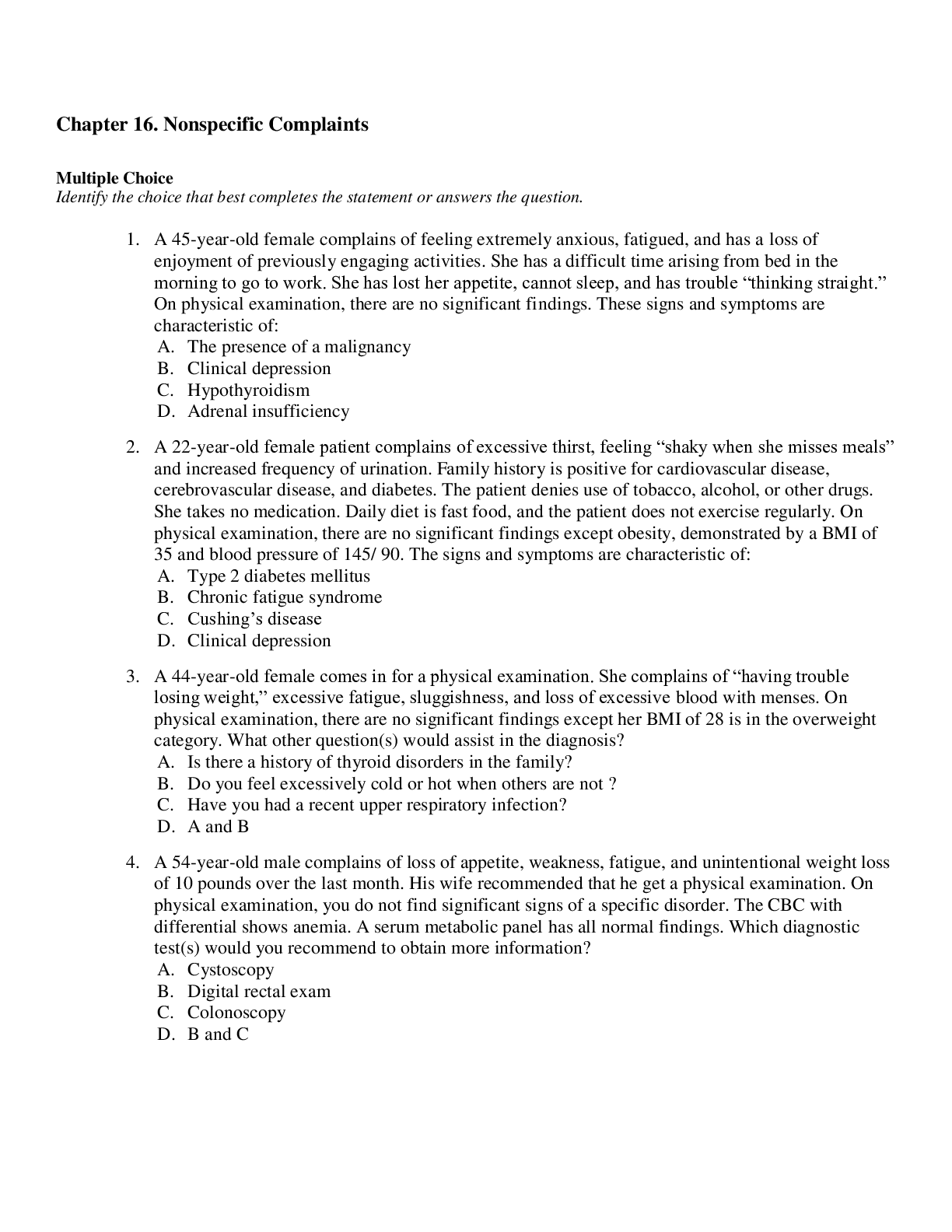
Buy this document to get the full access instantly
Instant Download Access after purchase
Add to cartInstant download
We Accept:

Reviews( 0 )
$9.00
Document information
Connected school, study & course
About the document
Uploaded On
Mar 02, 2020
Number of pages
13
Written in
Additional information
This document has been written for:
Uploaded
Mar 02, 2020
Downloads
0
Views
47

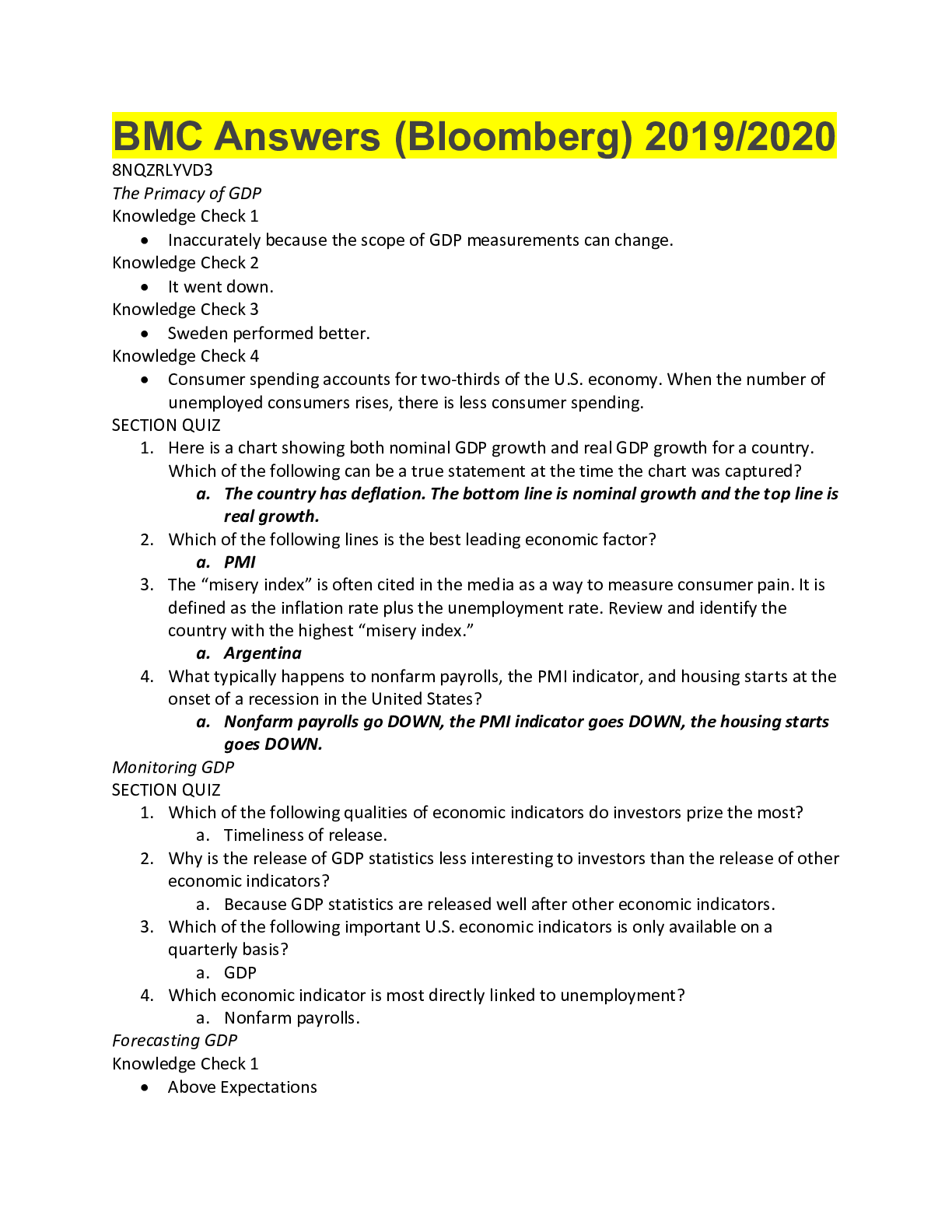
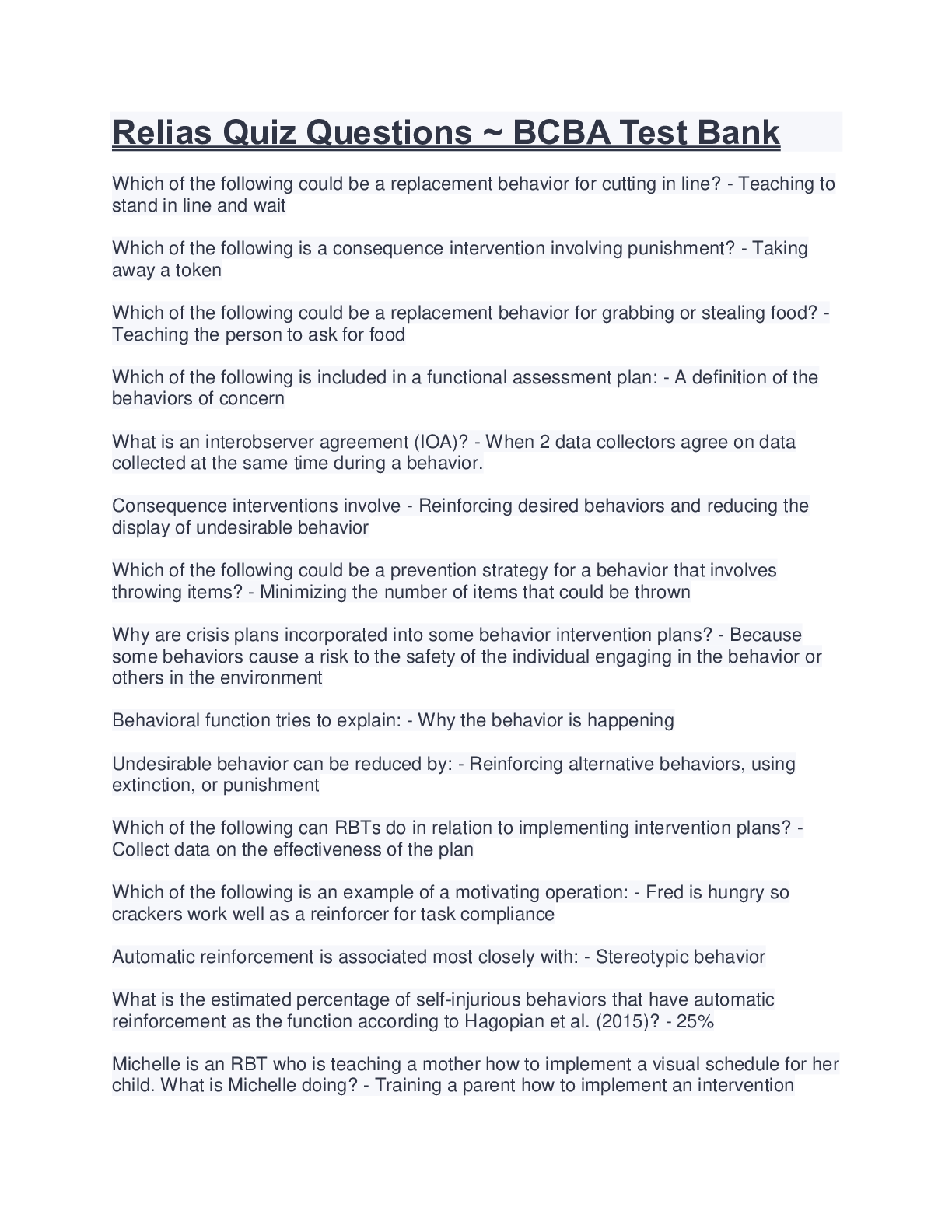
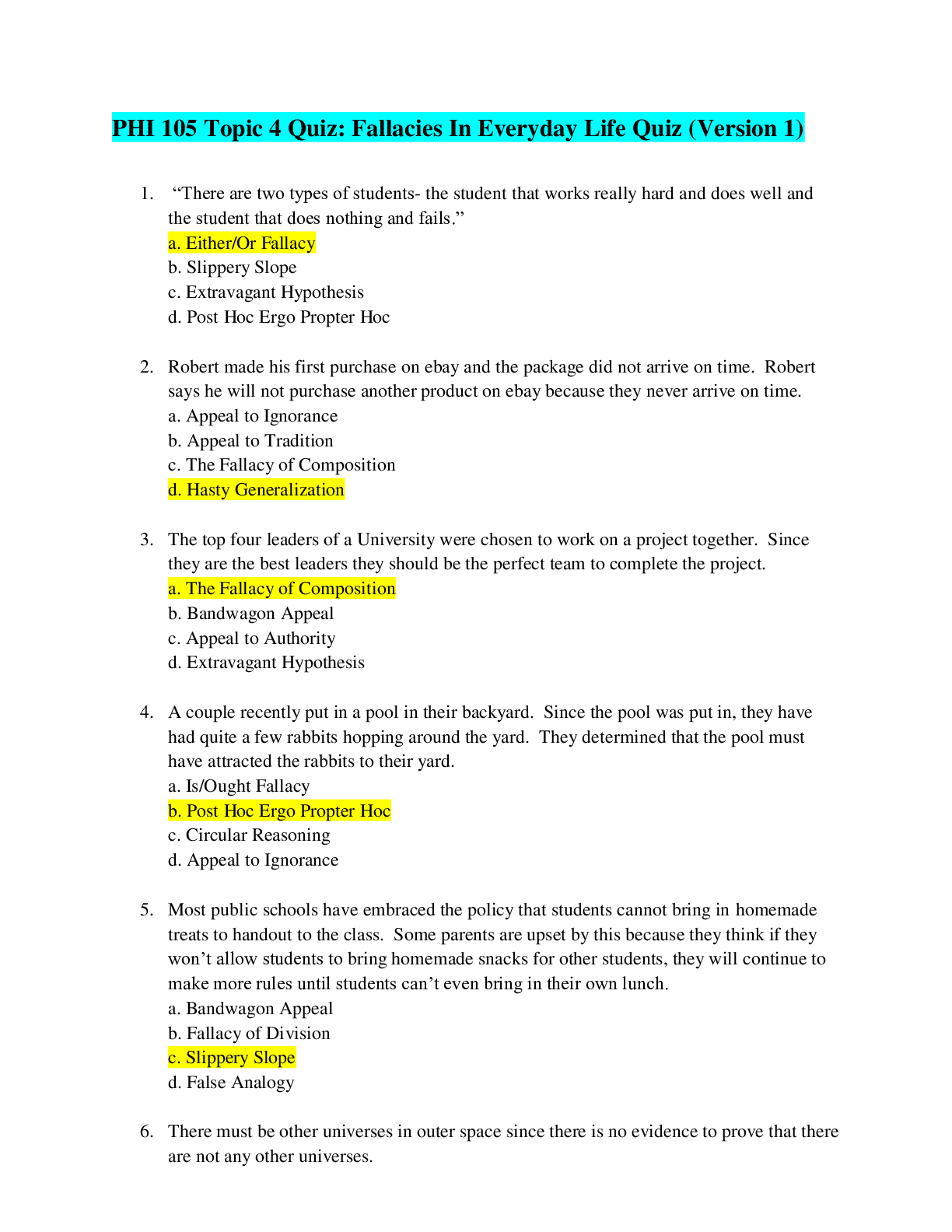


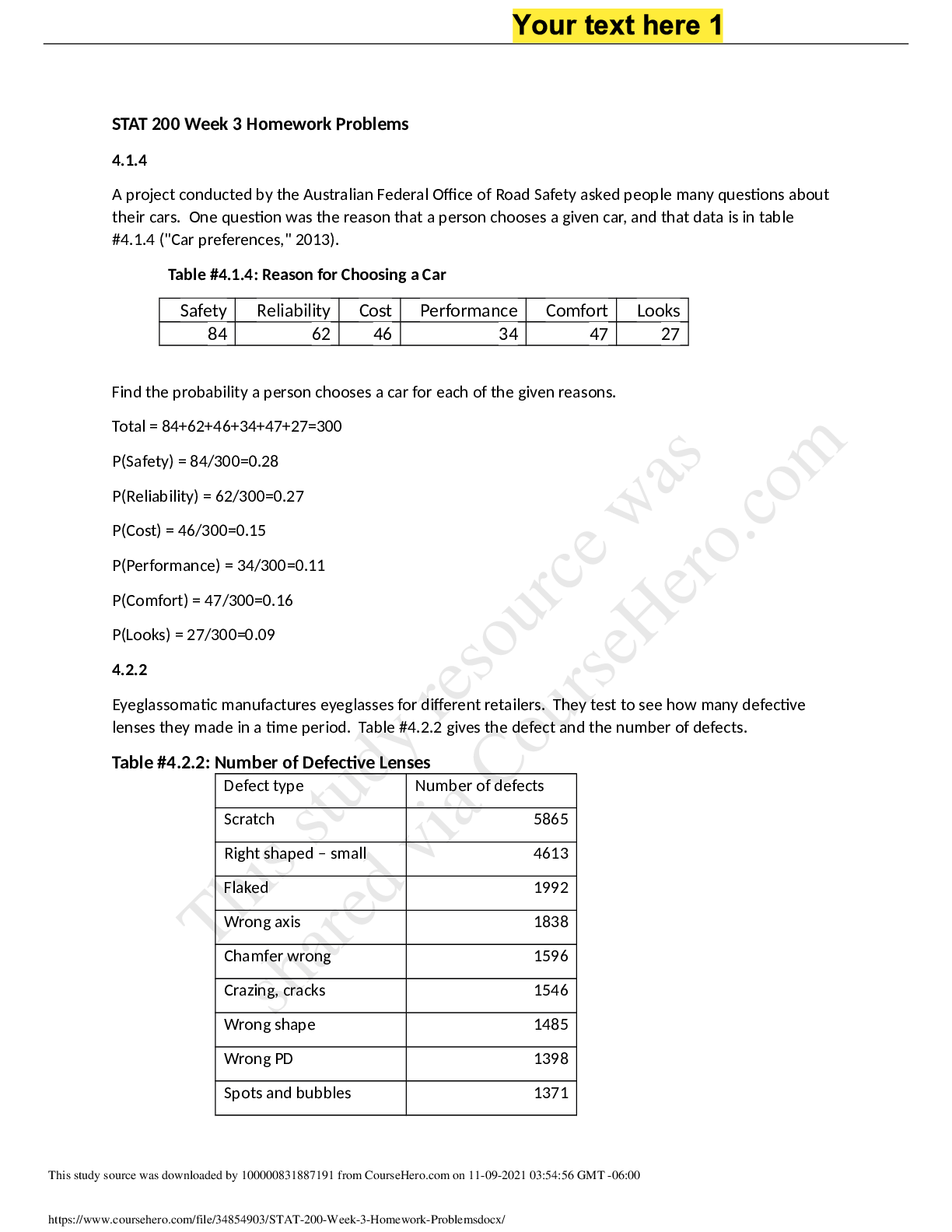

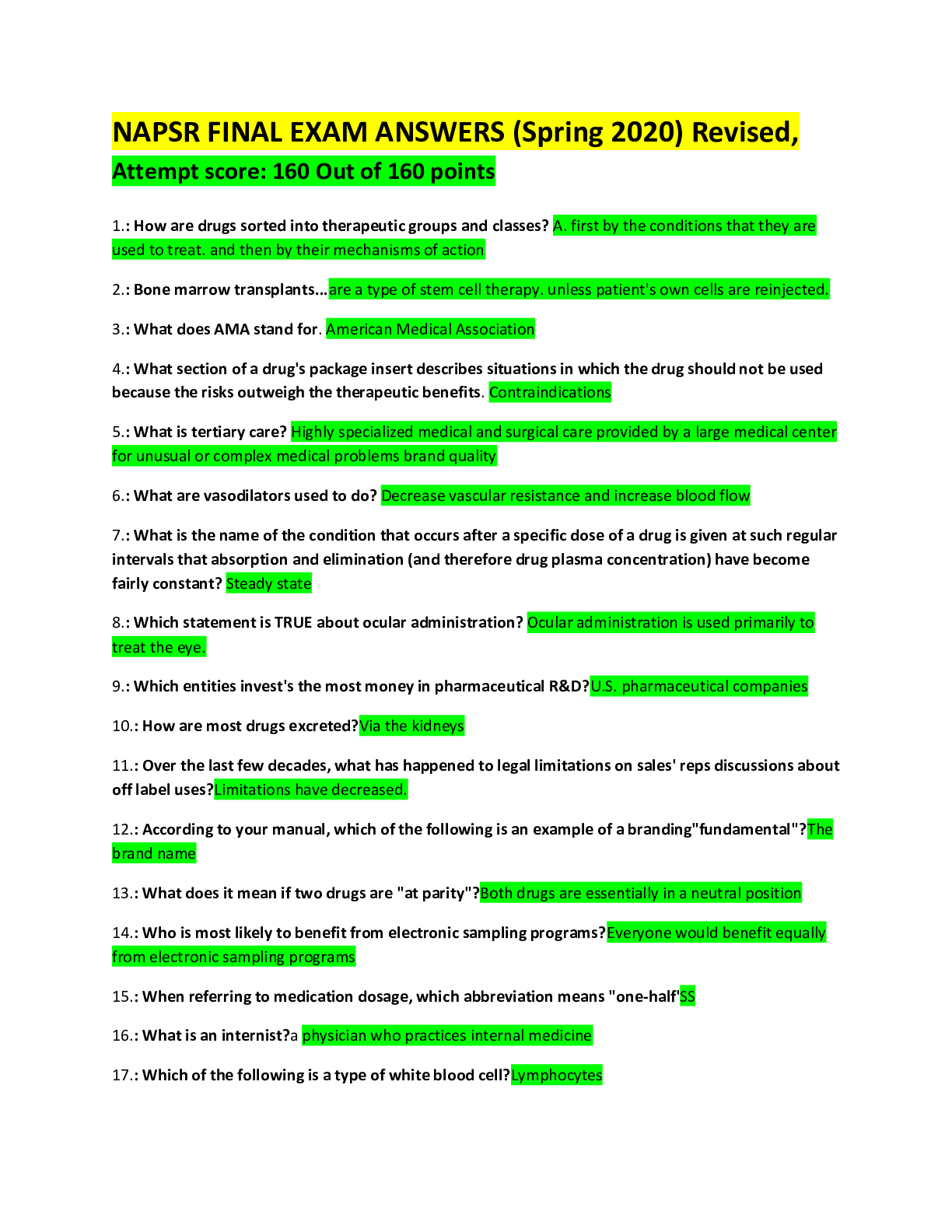

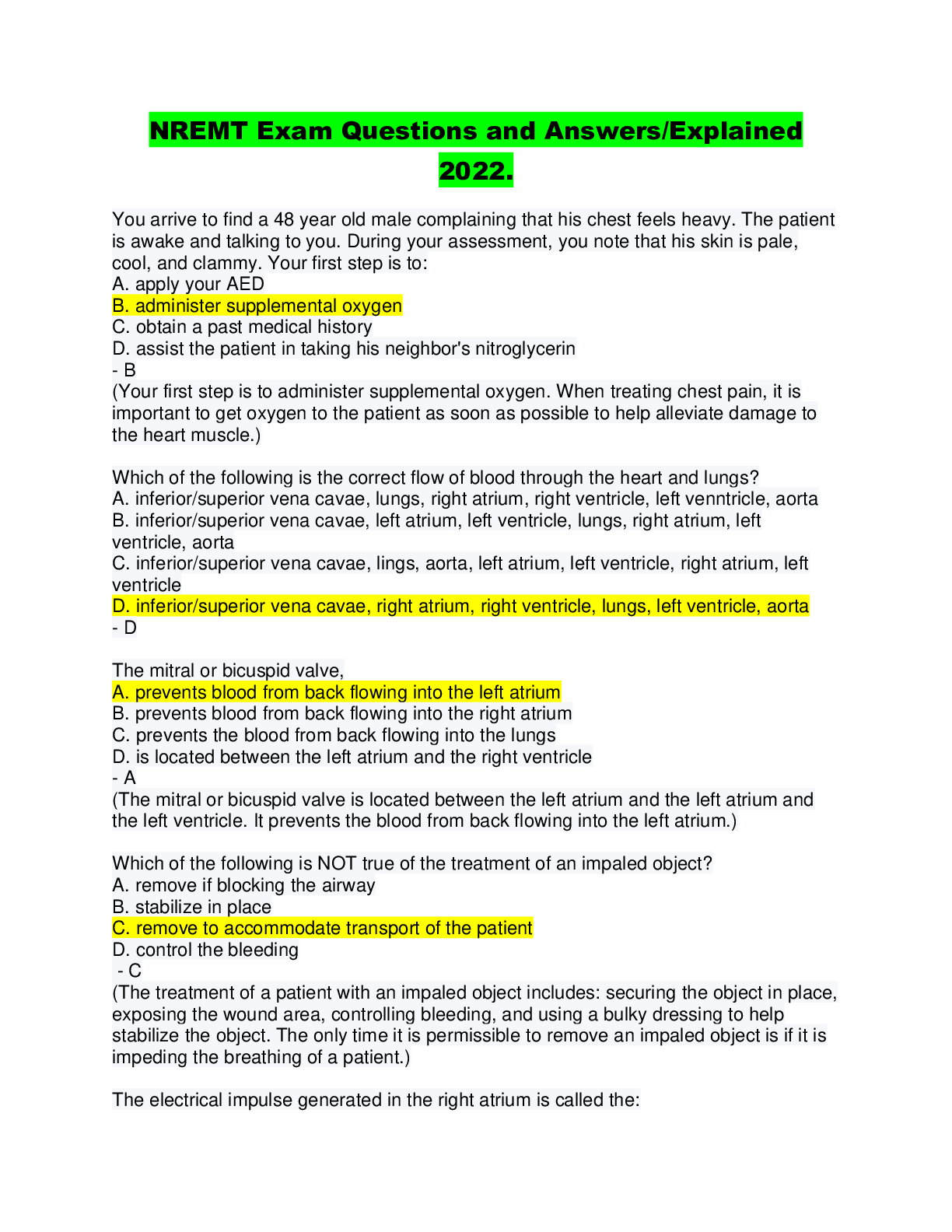
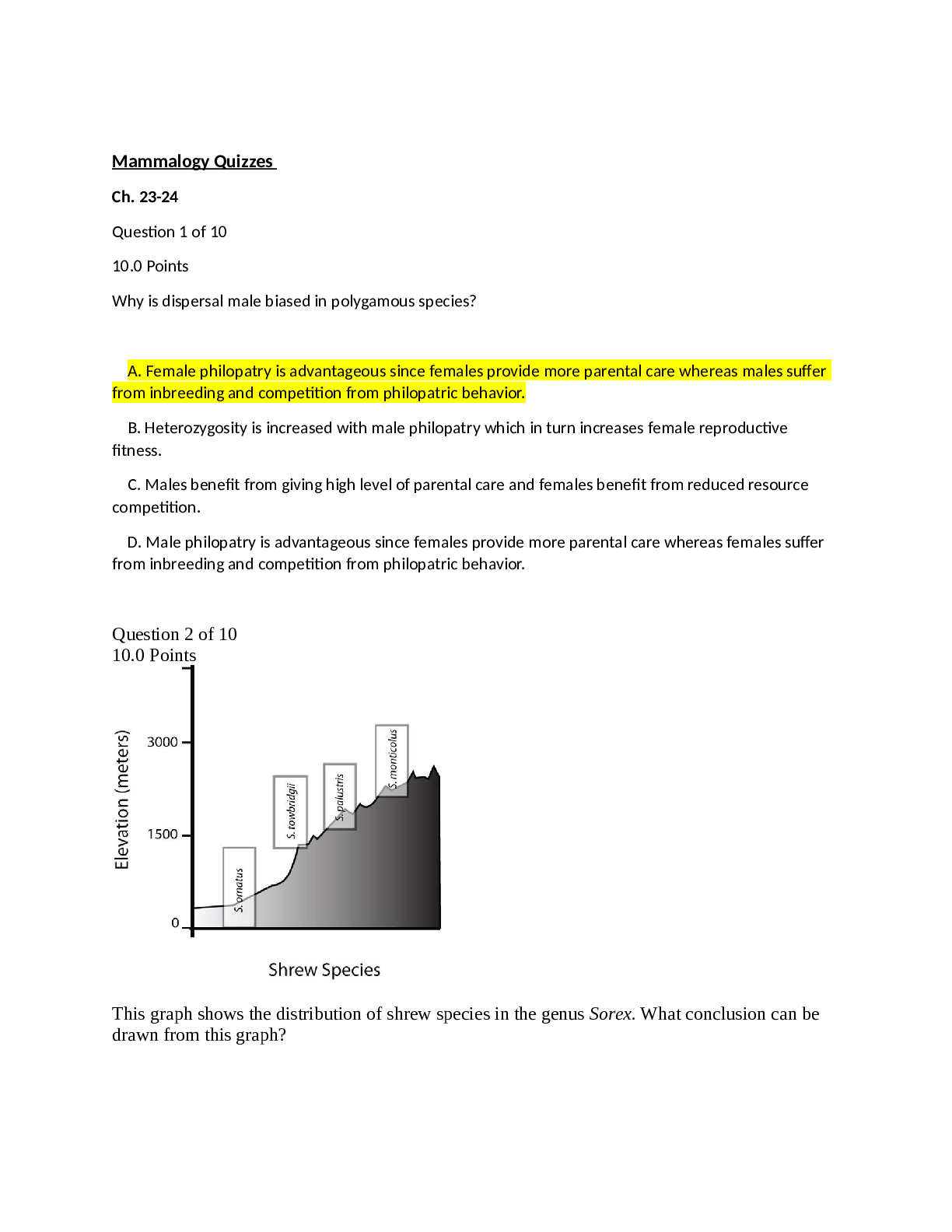
.png)

